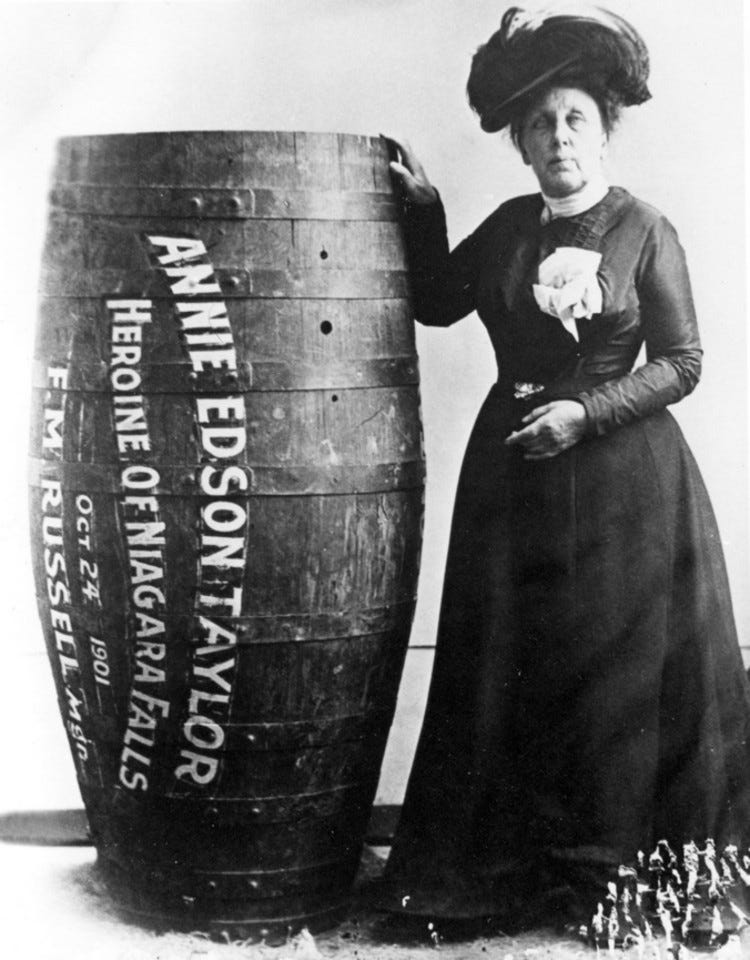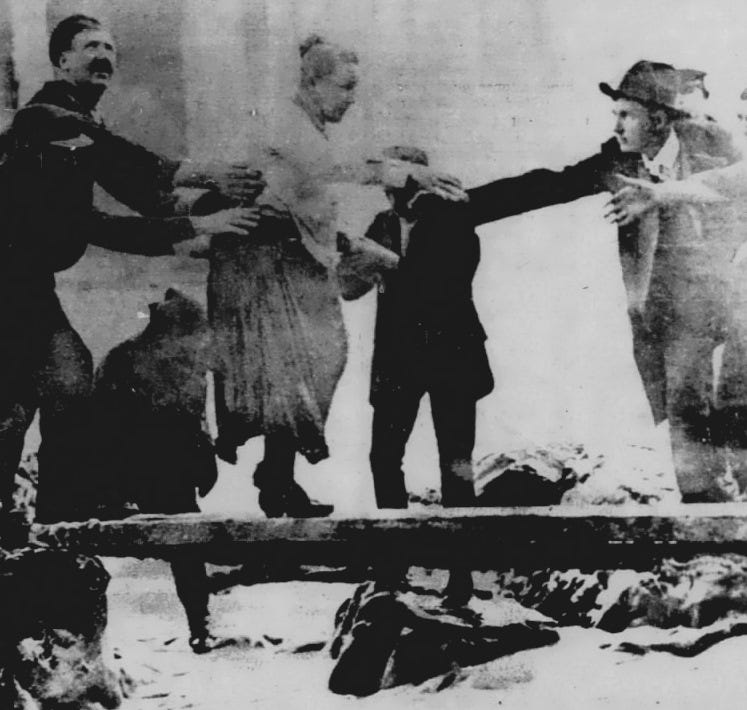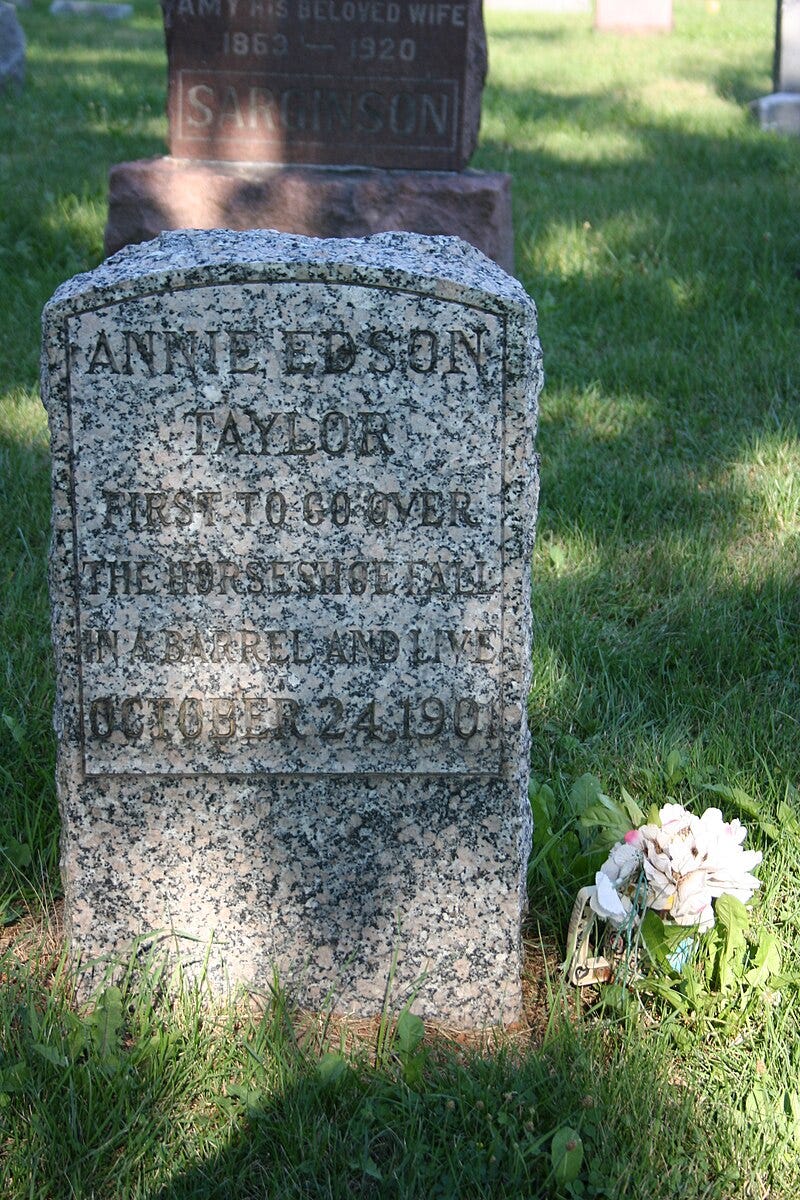The First Person to Survive Niagara Falls in a Barrel Had One Regret (And It's Not What You Think)
Annie Edson Taylor didn’t want to be famous. She wanted to avoid the poorhouse. In 1901, those were the same thing. Annie Edison Taylor was born in 1838, a time when the world was shifting beneath the feet of ordinary people. She lived long enough to see the dawn of the automobile, the expansion of railroads, and the rise of spectacle as a form of survival. By trade, she was a schoolteacher, and later, she set her sights on becoming a dance instructor in Bay City, Michigan. It was a modest ambition, one rooted in grace and rhythm, but life had other plans. Opportunities for work were scarce, and despite her efforts to establish a dance school, no students came. She traveled from place to place, searching for employment, but the doors kept closing. Eventually, she returned to Bay City, older now, facing the same fear that haunted many in her era: the poorhouse.
In 1901, a widow over sixty had few paths to solvency. Teaching jobs went to younger women; pensions were nonexistent. The poorhouse wasn’t just a fear—it was a statistical likelihood. The poorhouse loomed in the public imagination as a place of last resort, a cold, regimented existence for those who had nothing and no one. Annie Taylor was determined to avoid it. She had dignity, pride, and a growing sense that conventional paths would not save her. So she devised a plan that was as radical as it was dangerous: she would become the first person to go over Niagara Falls in a barrel. Directly over the edge—through the heart of the falls and, hopefully, out the other side alive. Not under it. Not around it. It wasn’t just a stunt; it was an investment. She believed that if she survived, she would be famous, and fame, she hoped, would be her pension.
She had earned an honors degree in teaching after a rigorous four-year training course, but by the time she turned sixty, those credentials meant little. Her husband had died young, as had their infant son, leaving her to navigate a world that offered few protections for widows. She'd moved from Texas to New York City, from North Carolina to Tennessee, even trying her luck in Mexico City with a friend, all in search of steady work. By 1900, she'd been burned out of her home and had lost money invested with a clergyman who turned out to be less than trustworthy. In the federal census that year, she shaved twenty years off her age, declaring herself born in 1860 instead of 1838—a small deception that might make her seem more employable in a world that discarded women as they aged. She'd always associated with "the best class of people, the cultured and refined," and believed that without money, she would lose her place in that world. The Niagara Falls stunt wasn't born of recklessness but of calculation: she'd heard that the 1901 Pan American Exposition in nearby Buffalo would draw enormous crowds to the region, and she knew that timing her plunge to coincide with this influx of tourists might secure her future.

The barrel was custom-built. Five feet tall, made of oak and iron, reinforced with leather straps and a steel band, it was designed to withstand the unimaginable force of the falls. Inside, she had a mattress to cushion the impact, a harness to keep her from being thrown around like a pebble in a tin can, and a heart-shaped pillow—perhaps a touch of sentiment, perhaps a final nod to the life she was risking. The lid was sealed shut with nails, and once she was inside, there was no turning back. No last words, no second thoughts. Just darkness, the sound of water growing louder, and then the river carrying her toward the brink.
Why a barrel, though? Why not a nice rowboat? Or one of those inflatable dinghies with the little oars? Surely easier to get in and out of without requiring a crowbar and a priest to administer last rites. But no—barrel it was. And honestly, when you think about it, the barrel makes a weird kind of sense. It’s like the original survival pod: watertight, sturdy, and already associated with holding things together under pressure—mostly wine, but also, apparently, one very determined schoolteacher. Barrels don’t capsize. They don’t have sails that catch the wind at the worst moment. They just tumble, spin, and eventually pop out the other side like a particularly soggy lottery ball. Plus, let’s be real, “Annie Edison Taylor, the woman who survived Niagara Falls in a wine cask” just sounds more dramatic than “the lady in the kayak who forgot her lifejacket.” It’s not just a container—it’s a statement. It says, “I didn’t come to paddle. I came to be violently ejected from nature’s washing machine and still make it to tea time.” And let’s not overlook the heart-shaped pillow. Was it comfort? A final nod to romance before chaos? Or just the only cushion that fit? We may never know. But one thing’s certain: if you’re going over Niagara Falls, best to go like a spirit aged to perfection—sealed, oak-aged, and slightly unhinged.
She'd tested her contraption days before the main event, sending a domestic cat over the Horseshoe Falls in the barrel to see if it would survive. When rescuers found the little creature seventeen minutes later, it emerged with barely a scratch, though with a bleeding head that would become part of the photographic record. The barrel itself was made of Kentucky oak secured by two iron hoops, standing four and a half feet tall and weighing 160 pounds—light enough to be maneuvered but heavy enough to stay upright in the churning water. An anvil sat on the floor to keep it from capsizing, while the mattress lining absorbed some of the impact. Taylor had supervised its construction closely, hiring a cooper to build it to her exact specifications, certain that only the sturdiest materials would protect her from the falls' crushing power. She'd lied to the press about her age through a manager who presented her as "a widow 42 years old, intelligent and venturesome," though she was actually sixty-three on the day of her attempt.
She went over on October 24, 1901, her sixty-third birthday. The journey down was not a fall so much as a violent descent into chaos. The barrel tumbled, spun, was crushed by the weight of the water, battered against rocks, dragged through the churning pool at the base. From the outside, it looked like destruction. From the inside, it was worse—darkness, pressure, the sensation of being shaken apart, the sound of wood groaning under strain. And then, stillness. Did she pray? Curse? Rehearse the lectures she'd give afterward, if she lived? The barrel surfaced. It was spotted, pulled ashore, and opened. Inside, Annie Taylor was alive. She had a small gash on her head, nothing more. She climbed out, dazed but unbroken, the first person in history to survive the plunge over Niagara Falls in a barrel.
Her first words were not triumphant. They were not celebratory. When asked how she felt, she said, "No one ought ever to go over the falls unless they cannot help it." Later, she elaborated: "If it was with my dying breath, I would caution anyone against attempting the feat." She compared the experience to walking up to the mouth of a cannon, knowing it would blow her to pieces. It was not a recommendation. It was a warning. And yet, she had done it anyway. She had gambled her life on the idea that survival would bring security. That fame would pay the rent. History would remember her as a pioneer rather than as a desperate woman. Today, we call it 'going viral.' Then, it was a barrel and a prayer. If Annie Edson Taylor were alive today, what would her 'barrel' be? A GoFundMe for a risky surgery? A TikTok stunt gone wrong? A crowdfunded moonshot (literally or metaphorically)?
For a time, it seemed like it might. She was photographed, interviewed, paraded as a marvel. But fame, as it often does, proved fickle. Managers took her money. Promoters exploited her story. She was cheated out of earnings, pressured into appearances she didn't want to make. She tried to sell photographs of herself, autographed cards, even pieces of the barrel, but the public's attention shifted quickly. Others began attempting the same stunt—some in barrels, some in contraptions even more absurd—turning her near-death experience into a circus act. She watched as imitators risked their lives for attention, some dying in the attempt, others surviving only to vanish into obscurity just as she had.
The barrel worked because it was designed to be watertight, to hold its shape under pressure. Unlike a boat, which could capsize or fill with water, a barrel was meant to float, to contain, to protect. It didn't matter if it rolled or tumbled; as long as it stayed sealed, the contents had a chance. That was the theory, anyway. In practice, it was a wooden coffin hurtling through a natural grinder. The mattress inside absorbed some of the impact, but not all. The harness kept her from being thrown against the walls with full force, but she was still battered, tossed, subjected to forces no human body was meant to endure. The heart-shaped pillow remained, a small absurdity in the midst of violence.
She had not set out to be a daredevil. She was not driven by a thirst for adrenaline or a need for applause. She was a woman with few options, looking for a way out of a future she feared more than death. The poorhouse represented loss of control, loss of dignity, a slow erasure of self. The barrel, for all its terror, was a choice. She built it, she climbed in, she faced the falls on her own terms. And when she emerged, she did so with the quiet certainty that she had done something no one else had dared. She was the first. That fact could not be taken from her, even if everything else was.
The very next day, Taylor told reporters she would "sooner walk up to the mouth of a cannon, knowing it was going to blow me to pieces than make another trip over the fall." But the world wasn't interested in her wisdom—it wanted spectacle. She briefly earned money speaking about her experience, receiving $200 for appearing at the Pan American Exposition and another $200 for store appearances in Michigan and Ohio with her cat and barrel. But no lecture tour ever materialized, and she soon went broke. She made the mistake of hiring a manager named Frank M. Russell, whom she later called her "great mistake," because he absconded with her famous barrel and hired a young woman to impersonate her on publicity tours. Taylor spent much of her savings hiring private detectives to retrieve her barrel, which was eventually located in Chicago—only to be stolen again by a new manager named William A. Banks. Within a couple of years, she was a fixture outside a restaurant on the American side of the falls, sitting alongside a replica barrel, selling postcards and her slim memoir to tourists making their way to the falls. She tried everything to scrape by—working as a clairvoyant, providing magnetic therapeutic treatments to locals, even briefly talking about taking a second plunge over the cataracts in 1906. She attempted to write a novel and even tried to reconstruct her 1901 plunge on film (which was never seen), all while watching her story become diluted by imitators and frauds.
She lived for many years after the fall, but never found the financial stability she had hoped for. She gave lectures, told her story, tried to capitalize on her moment in the spotlight, but the world moved on. She entered the Niagara County Infirmary in Lockport, New York, claiming to be only 57 years old, though she was actually 82. She died on April 29, 1921, penniless, her funeral paid for by public donations. Her grave in Niagara Falls is marked simply: "Annie Edson Taylor." The spelling of her name had shifted somewhere along the way—Edison to Edson—but the name remained. She was buried in the "Stunter's Rest" section of Oakwood Cemetery, next to her friend and fellow daredevil Carlisle Graham, the first man to run the Niagara rapids on a raft. A woman who risked everything to avoid being forgotten, and who, in the end, was forgotten anyway. Not entirely, though. Every now and then, someone remembers. Someone reads the story. Someone imagines the barrel, the darkness, the roar, and the woman inside, holding on, waiting for the end that didn't come.
In a strange irony, while Taylor struggled to gain recognition in her own time, her story has endured in ways she could never have imagined. Today, her name and likeness appear all over Niagara Falls, yet beyond the superlative "first to survive," her story has been lost somewhat to the mist of time. She has become what artist Jordyn Stewart calls a "lost feminist folk hero"—a woman who had to literally throw herself off a waterfall for recognition, and even then, it wasn't enough. Stewart noticed that every historical depiction of Niagara Falls had been created by male artists, and that the collections housing them were overwhelmingly male as well. The very same forces that diminished Taylor's efforts persist still today across many fields. Her tale has inspired an epic poem, a musical called "Queen of the Mist," appearances in television shows, and even a song on Trapper Schoepp's 2023 album "Siren Songs." The barrel is gone. The falls still roar. And every so often, someone looks at her grave and wonders: Was it worth it? The answer might depend on whether you believe survival is enough when the world refuses to see you as anything more than a spectacle.


Comments
Post a Comment